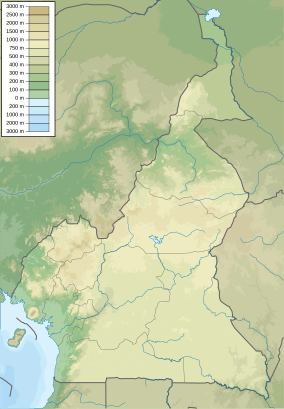Bouba Njida National Park is a national park of Cameroon. A total of 23 antelope species occur in the park.[1] The painted hunting dog, Lycaon pictus, had been observed in Bouba Njida National Park at the start of the 21st century. This population of the endangered canid is one of the few that remained in Cameroon as of the year 2000.[2]
| Bouba Njida National Park | |
|---|---|
| Location | |
| Coordinates | 8°37′25″N 14°39′24″E / 8.62361°N 14.65667°E |
| Area | 2200 km2 |
| Established | 1980 |

In 2012, heavily armed poachers from Chad and Sudan massacred some 200 savannah elephants while on horseback thus wiping out more than half of the elephant population of the Bouba N’Djida National Park.[3]
Background
editBouba Njida National Park covers an area of 220,000 hectares (540,000 acres). Initially it was established as a reserve in 1932. It was upgraded to level of park in 1980.[4] The park is reported habitat is of savannah forest and the average elevation varies from 251 to 864m. The park receives an average annual rainfall of 1082 mm.[5] The park is categorized under IUCN II. The painted hunting dog, Lycaon pictus, considered critically endangered by IUCN has a count of 60 within Cameroon and they are reported from this park apart from two other national parks in the country. A total of 23 antelope species occur in the park.[6]
See also
edit
Notes
edit- ^ S.N. Stuart, Richard J. Adams, Martin Jenkins. 1990
- ^ C. Michael Hogan. 2009
- ^ Wassener, Bettina (March 16, 2013). "China's Hunger for Ivory is Killing Cameroon's Elephants". The New York Times. Retrieved May 12, 2014.
- ^ Mesmin Tchindjang; Clair Réné Banga; Appolinaire Nankam; Jean Sylvestre Makak (2001). "Mapping of Protected Areas Evolution in Cameroon from the Beginning to 2000: Lesson to Learn and Perspectives" (PDF). Table 1 World Wildlife Organization. World Wildlife Organization. Retrieved 14 February 2013.
- ^ "Bouba Ndjidal National Park". European Union. Archived from the original on 12 April 2013. Retrieved 20 February 2013.
- ^ S.N. Stuart, Richard J. Adams, Martin Jenkins. 1990
References
edit- C. Michael Hogan. 2009. Painted Hunting Dog: Lycaon pictus, GlobalTwitcher.com, ed. N. Stromberg
- S.N. Stuart, Richard J. Adams, Martin Jenkins. 1990. Biodiversity in sub-Saharan Africa and its islands: conservation, management, and sustainable use, Biodiversity Conservation Strategy Programme, International Union for Conservation of Nature and Natural Resources. Species Survival Commission, Published by IUCN, 242 pages ISBN 2-8317-0021-3, ISBN 978-2-8317-0021-2
